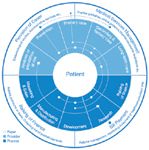A Brave New Path for Pharma
Personalized medicine and integrated healthcare delivery require new business and pricing models. This article contains bonus online-exclusive material.
Despite unprecedented demand for its products in a global market that is expected to double in value by 2020, the pharmaceutical industry is at a pivotal point in its evolution. The industry faces the same dilemma that the music business encountered during its digital transformation and that the automobile industry is grappling with today: change or be changed.

Anthony Farino
The pharmaceutical industry can isolate itself in a diminishing linear business model that is growing weaker as blockbuster patents expire, generic competition whittles away market share, and fewer new drugs prove innovative and economically viable. Or, the industry can channel a whirlwind of technological, scientific, social, and economic change into innovative business models that are more relevant to today's outcomes-focused healthcare delivery system.
To build these new business models, each pharmaceutical company must identify and focus on its core strengths rather than trying to control every aspect of the value chain (see Figure 1). While concentrating on core strengths, companies can form collaborative partnerships and alliances that envelop product with service offerings to drive superior patient outcomes. Healthcare delivery networks will link pharmaceutical companies, device manufacturers, payers, providers, research organizations, academic institutions, health and fitness centers, and technology companies.

Figure 1: The pharmaceutical value chain.
By combining the resources of diverse organizations, industry can meet and exceed future market demands. With this type of business model, companies will be able to produce personalized packages of products and services that include diagnostics, medications, wellness, and compliance programs. Prescription therapies, which might come from competing manufacturers and include generic drugs, will be only one component of this package.
Innovating research and development
In a more patient-centic business model, the pharmaceutical industry must direct its research and development (R&D) investment to products that the healthcare market defines as truly innovative. The industry must seek the involvement of public and private payers, providers, and patients by reaching out to these stakeholders earlier in the R&D process to ensure that products are viewed as innovative.
To develop new medicines, companies will need to continue to tap into academic research and biotechnology. Mergers and acquisitions can beef up product portfolios, but companies will need to rely more heavily on in-licensing and partnerships to accomplish the same goal at a faster rate and at lower cost. Megamergers may become less typical in the future because many have tended, in the past, to stifle creativity and failed to deliver sustainable cost reductions.
The most dramatic R&D changes will come in the way clinical trials are conducted. Clinical trials will become smaller, more targeted, and more iterative as regulators allow "live licensing" (in-life testing) to vet the safety and efficacy of therapies in selective patient groups before expanding to larger or different populations. In this environment, R&D will concentrate on complex, targeted products. Demand will shift to specialized medicines, primarily in the form of biologics. Although biologics are more complicated to develop, manufacture, and distribute, they hold industry's greatest hope for sustained profitability.
Focusing on outcomes
With advances in genomic research, lower-cost genetic mapping, and comparative effectiveness studies, industry will be better equipped by 2020 to determine which medicines have the most potential for delivering positive outcomes to specific patient subpopulations. This ability will be critical as health insurers and the federal government increasingly refuse to pay for therapies that fail to deliver cost-effective results. This "value-based purchasing" or "evidenced-based medicine" will further intertwine the value chains of payers, providers, and pharmaceutical companies, with each owning a stake in treatment effectiveness.
As the US Congress considers creation of a program for universal healthcare coverage, a strong likelihood exists for more government pressure on pharmaceutical companies to lower drug prices. An early indication of this move was illustrated last May when President Obama discussed a pledge by a consortium of executives from leading payers, providers, and pharmaceutical manufacturers committed to reduce the annual growth of healthcare spending by 1.5%—an expected savings of more than $2 trillion by 2018. In emerging markets, governments seeking to expand healthcare access for their surging populations also will demand price concessions. Broader access and rising incomes in emerging markets, however, may result in a higher number of prescriptions being written and may help offset some profit erosion.
Around the globe, technology-enabled outcomes measurement will drive product development, pricing, and reimbursement decisions, as well as risk-sharing arrangements. Electronic health records, ePrescribing, remote monitoring, pharmacovigilance systems, and other technologies will yield extensive, real-time outcomes data on the effectiveness of medicines. With appropriate privacy safeguards, monitoring this treasure trove of data will enable pharmaceutical companies and other organizations to more closely observe and encourage patient compliance. Better patient compliance will improve health, build broader product demand, and grow profits.
Changing marketing tactics
The physician-focused marketing practices that drove the industry's profits in the past have become increasingly less effective. As more companies develop specialized therapies, a differentiated approach to sales and marketing is needed. Also, new rules and regulations governing interactions with healthcare professionals and others will require pharmaceutical companies to change long-accepted sales and marketing practices. New technologies such as machines that dispense drug samples in physician offices will alter the nature of interactions between physicians and sales representatives (see Figure 2).

Figure 2: An intertwined value chain including pharmaceutical companies, payers, and healthcare providers.
The industry already has reduced by thousands the number of sales representatives in the US. A change in focus to improving patient outcomes also will require sales and marketing teams to liaise more frequently and earlier in the product development process with their company's R&D department. They will need to actively engage the capabilities of their health economics function in the areas of pricing and reimbursement.
Collaborating on business models
As the industry moves toward broader collaboration with stakeholders, PricewaterhouseCoopers (PWC) sees two distinct business models emerging (1).
A federated model. Federations retain core functions such as intellectual property management, contracting, and information technology, in hub organizations. These hubs rely on internal and external resources to provide a full range of healthcare services. Two variations of the federated model are venture (based on a portfolio of investments and risk sharing) and virtual (a network of contractors managed by a hub organization).
A fully diversified model. A diversified company offering a full suite of healthcare products and services can give its business units a high degree of independence to encourage innovation and spread risk.
To prepare for these collaborative business models, pharmaceutical companies must employ staff well versed in healthcare delivery with skills to build brands, manage networks of external alliances, negotiate with governments and health insurers, liaise with secondary-care specialists, and communicate with patients. These new skills and business models will position the industry to revitalize R&D, serve emerging markets, and make the transition from a focus on medicines production to a focus on managing outcomes. The pharmaceutical industry has a rare opportunity to redefine itself and to redeem its public image while sustaining profitability. But industry must adapt to a brave new world of integrated healthcare delivery.
Anthony Farino is PricewaterhouseCoopers' US Pharmaceutical and Life Sciences Advisory Services leader, anthony.l.farino@us.pwc.com
Reference
1. PWC, Pharma 2020: Challenging Business Models—Which Path Will You Take?, April 2009, www.pwc.com/pharma2020.
